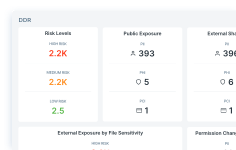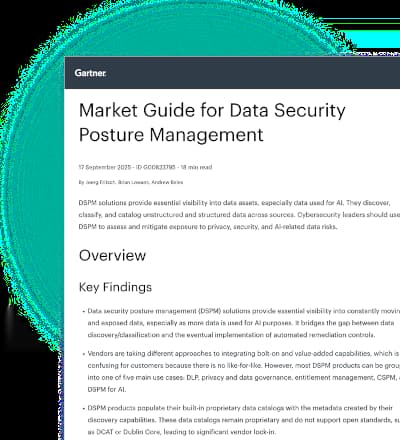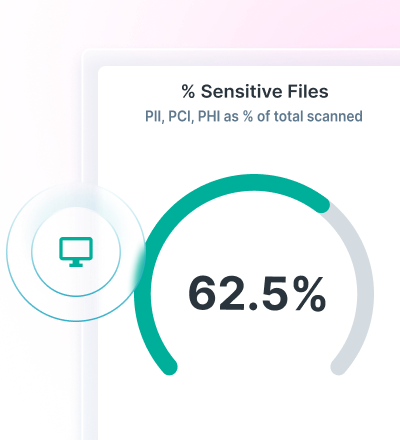Selecting the Right DSPM Solution for Cloud Security: A Comprehensive Guide
0 min read

Tim Herr
As cloud adoption accelerates and data sprawls across SaaS apps, multi-cloud platforms, hybrid infrastructure and AI/ML pipelines, organizations face unprecedented data security challenges. Shadow data, misconfigurations, over-permissioned identities and expanding compliance demands now emerge faster than traditional tools can address.
This is why Data Security Posture Management (DSPM) has become a foundational component of modern cloud security. DSPM provides visibility into where sensitive data lives, how it is used and where it may be exposed – enabling proactive risk reduction and stronger compliance outcomes.
In this guide, you’ll learn how to choose a DSPM solution for cloud security, which capabilities matter most, the steps to evaluate vendors and why Forcepoint DSPM, powered by AI Mesh technology, is uniquely positioned to address today's data-centric risks.
The Importance of Choosing the Right DSPM for Cloud Security
The exponential growth of cloud data has reshaped enterprise risk. Shadow data – data stored outside sanctioned systems or workflows – is increasingly common and contributes significantly to breaches and compliance violations. Traditional tools often lack the visibility and context needed to protect sensitive data across distributed, dynamic environments.
Selecting the right DSPM solution is essential because it enables organizations to:
- Identify where sensitive data resides
- Classify and contextualize data with high accuracy
- Map permissions and usage
- Prioritize risks based on actual exposure
- Remediate incidents with automation
Forcepoint DSPM fills visibility gaps with comprehensive data discovery and highly accurate AI-driven classification. Organizations evaluating DSPM can explore these capabilities firsthand through a Forcepoint DSPM demo early in the assessment process.
Understanding Data Security Posture Management (DSPM)
DSPM is a data-centric security approach designed to discover, classify, assess and remediate risks across AI apps, cloud, SaaS and on-prem environments. It provides the holistic view needed to understand and address sensitive data exposures.
DSPM typically delivers the ability to:
- Enhance visibility into sensitive and regulated data
- Classify information based on sensitivity and business context
- Map user permissions and behavior
- Assess and prioritize risk in real time
- Remediate exposures through guided or automated workflows
DSPM complements security stacks that include DLP, CASB and Data Detection and Response (DDR), enabling a unified data protection strategy.
Why Organizations Need DSPM in the Cloud Era
The rise of cloud apps, remote work and DevOps agility has intensified data sprawl. Organizations now face:
- Shadow data and unsanctioned repositories
- Misconfigured cloud storage buckets
- Over-permissioned identities and roles
- AI/ML pipelines storing sensitive data
- Compliance exposure across GDPR, CCPA, HIPAA, PCI DSS and NIS2
Forcepoint DSPM helps address these challenges through highly accurate discovery, classification and alerting. This reduces false positives, improves analyst efficiency and enhances the accuracy of incident detection.
How to Choose a DSPM Solution for Cloud Security in 5 Steps
Once have evaluated DSPM against other options, choosing the right solution requires both strategic alignment and technical evaluation. Follow these five practical steps:
1. Assess Your Data Security Needs
Before evaluating vendors, determine your DSPM use cases:
- What cloud and SaaS platforms do you use?
- How much unstructured and shadow data exists?
- What compliance frameworks apply to your datasets?
A clear understanding of your security and compliance landscape helps narrow solutions that align with your risk profile.
2. Inventory All Data Sources
Catalog all relevant data repositories – including cloud storage, endpoints, SaaS apps, on-prem systems and shared file locations. DSPM is most effective when it can discover all sensitive data, including unknown or unmanaged shadow data.
3. Define Required Capabilities
Use the key DSPM features outlined below to establish a shortlist of must-have capabilities. Identify gaps in visibility, classification or remediation in your current environment.
4. Evaluate Vendors with Demos and POCs
When comparing DSPM tools, assess:
- Classification accuracy vs. false-positive rates
- Coverage across cloud, SaaS and on-prem data
- Real-world performance during discovery
- Integration with existing tools (DLP, DDR, SIEM, SOAR)
- Remediation workflows and risk prioritization
A proof of concept (POC) reveals how well a DSPM solution operates at your scale.
5. Evaluate Integration, Scalability and ROI
Consider how each DSPM solution will integrate with your ecosystem and support long-term growth.
- Does it unify with DLP, DDR or CASB?
- Can it analyze and protect data across multi-cloud architectures?
- Does it reduce manual investigation and compliance workload?
Organizations should choose DSPM that improves operational efficiency and provides measurable security outcomes.
7 Key DSPM Capabilities to Keep in Mind When Evaluating Solutions
The following capabilities represent the most important criteria when comparing DSPM vendors.
1. Automated Data Discovery
The platform should automatically discover data across multi-cloud, SaaS and on-prem ecosystems—including shadow data. Continuous visibility is essential for reducing exposure.
2. Risk-Based Classification
Classification must be context-aware, factoring in:
- Data sensitivity
- User permissions
- Behavioral activity
- Business metadata
Forcepoint AI Mesh enhances classification accuracy while reducing false positives.
3. Continuous Monitoring
DSPM should monitor sensitive data access patterns, sharing and modifications. Integration with Forcepoint DDR adds visibility into data in use.
4. Incident Analysis and Prioritization
The solution must correlate sensitivity, permissions and user activity to highlight the most critical exposures.
→ Identify and Prioritize Sensitive Data
5. Proactive Remediation
Leading DSPM platforms support automated or guided remediation, enabling teams to reduce risk quickly. Examples include fixing storage misconfigurations, removing public links or revoking unnecessary access.
6. Integration with Security Tools
DSPM should enhance – not replace – existing tools. Enable unified data protection workflows through deep integrations with:
- DLP
- DDR
- CASB
- SIEM/SOAR
7. Scalability and Performance
Evaluate each vendor’s ability to:
- Handle large volumes of structured and unstructured data
- Operate across multi-cloud architectures
- Meet data residency and privacy requirements
Forcepoint DSPM offers rapid, scalable discovery and classification for enterprise environments.
Questions to Ask When Choosing DSPM for Cloud Security
Use these categories to guide vendor discussions:
Data Discovery and Coverage
- Can the platform automatically discover shadow data?
- Are all major clouds and SaaS platforms supported?
Classification Quality
- How does the platform reduce false positives?
- Is classification pattern-based, AI-driven or context-rich?
Risk Management
- How are risks prioritized?
- Does the platform correlate permissions, activity and sensitivity?
Remediation Capabilities
- Are workflows automated, guided or manual?
- Can remediation be enforced through integrated DLP or DDR?
Top Tips from CISOs on Choosing a DSPM Solution for Cloud Security
1. Prioritize Contextual Accuracy
CISOs emphasize choosing DSPM solutions that rely on context-aware, AI-driven classification rather than pattern matching, which generates excessive false positives.
2. Focus on Ecosystem Integration
DSPM should integrate with tools you already rely on, such as DLP or CASB, to create a unified and efficient data protection workflow.
3. Validate Cloud App Coverage
Ensure the DSPM solution can discover and protect data stored across all SaaS and cloud apps used by your organization.
4. Demand Real Remediation
CISOs caution against solutions that only identify risks. Choose platforms capable of automated or guided remediation.
Best Practices to Follow and Maximize ROI on a DSPM Solution
Follow these best practices to ensure long-term DSPM success:
- Perform thorough discovery and classification at the outset
- Engage security, governance and compliance stakeholders early
- Define clear policies for handling sensitive data
- Automate remediation where appropriate
- Continuously refine classification rules as new data sources emerge
Common pitfalls include:
- Selecting discovery-only tools without remediation
- Underestimating the scope of unstructured and shadow data
- Overlooking compliance reporting requirements
Choosing Forcepoint DSPM for Cloud Security
Forcepoint DSPM is designed for organizations managing:
- Large volumes of shadow or unclassified data
- Over-permissioned identities
- GenAI-related data leakage concerns
- Distributed multi-cloud and hybrid environments
It also safely enables the adoption of GenAI, securing usage of tools like Microsoft Copilot and ChatGPT Enterprise with visibility and remediation controls.
By choosing Forcepoint DSPM, organizations gain:
- Highly accurate AI-driven discovery
- Context-rich classification
- Risk-based prioritization
- Integrated remediation workflows
- Unified security with DLP and DDR
Frequently Asked Questions on Choosing a DSPM Solution for Cloud Security
1. What are the differences between DSPM and DLP?
DSPM focuses on discovering, classifying and assessing data risk, while DLP enforces policies to prevent data loss. DSPM identifies where data is and whether it is exposed; DLP applies controls to stop sensitive data from leaving approved boundaries. The two work best when integrated.
2. What are the different types of DSPM available?
DSPM solutions vary by coverage (cloud, SaaS, on-prem), discovery methods (agentless, API-based), classification techniques (pattern-based vs. AI-driven) and depth of remediation capabilities.
3. How do you implement a DSPM solution in a cloud environment?
Implementation typically involves connecting cloud platforms via APIs, running initial discovery scans , validating classification accuracy, prioritizing risks and integrating remediation workflows. Collaboration across security, IT and compliance teams ensures alignment.
4. How can you protect sensitive data in the cloud?
Protection requires continuous discovery, context-based classification, strong access controls, monitoring for risky behavior and automated remediation. DSPM enhances all these capabilities by providing visibility and risk intelligence.

Tim Herr
Read more articles by Tim HerrTim serves as Brand Marketing Copywriter, executing the company's content strategy across a variety of formats and helping to communicate the benefits of Forcepoint solutions in clear, accessible language.
 Executive Guide to DSPM: Visibility and Control over Sensitive DataRead the eBook
Executive Guide to DSPM: Visibility and Control over Sensitive DataRead the eBook
X-Labs
Get insight, analysis & news straight to your inbox

To the Point
Cybersecurity
A Podcast covering latest trends and topics in the world of cybersecurity
Listen Now









